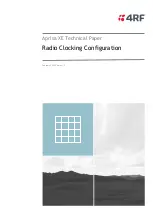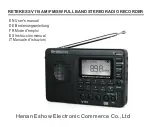
Quick Start Guide for AIT5000 V2.00
TEL + 44 1179 554474 www.digitalyacht.co.uk
Installation Step 5
– N2Net (NMEA2000)
•
The AIT5000
also has an N2Net connection which is Digital Yacht’s NMEA2000 compliant interface. To connect
to other NMEA2000 products, simply find or add a spare NMEA2000 “T” piece on the existing NMEA2000
network and connect the AIT5000
N2Net connector to the “T” piece.
•
The N2Net cable is just over 1m long and is terminated in an NMEA2000 Micro Male Connector.
•
The AIT5000 does not take any power from the NMEA2000 network
•
The AIT5000 outputs AIS and GPS data on to the network. All currently (Dec 2018) defined AIS PGNs are
transmitted including those for Class B+ Static Data, AIS Sarts and AIS AtoNs, which some chart plotters do not
support.
•
The AIT5000 does not convert any of the NMEA0183 data that it receives in to NMEA2000 data or vice versa.
Installation Step 6
– USB Interface
•
The USB cable of the AIT5000 can be used for configuring/programming the unit during installation using the
proAIS2 software for PC or Mac. However, the AIT5000 also features a new web interface that can be used for
this purpose and which this Quick Start Guide focuses on. If you want more information about configuring the
AIT5000 using proAIS2, please visit https://digitalyacht.net/2019/06/12/configure-an-ais-transponder/
•
If you intend to permanently connect the AIT5000 to a PC or MAC via a USB interface, we recommend that you
use one of our NMEA to USB adaptor cables (P/No ZDIGUSBNMEA) which will protect the AIT5000 from voltage
differences, noise and electrical spikes that can occur in marine installations.
•
When connected to a PC or MAC via the USB cable, the AIT5000 will only get enough power from the computer
to power the microprocessor and the AIS receiver. This allows you to program the MMSI number and other static
data at home or in the office prior to installation. The AIT5000 will not transmit or get a valid GPS position fix
when only powered from the USB interface and the RED Status LED will always be lit when powered from the
USB cable.
•
If you need to extend the USB cable, please use a USB extension cable that is no more than 4m in length. The
maximum length of USB cable without the use of a powered extender cable or Hub is 5m.
•
Please do not plug in the USB cable of the AIT5000 to your PC. We will cover this in section 4 - Configuration.
Installation Step 7
– Remote Switch
•
To connect a remote “Silent” switch that allows you to turn on/off the transmission of your own vessels position
(good etiquette when moored or in congested but safe conditions), you will need a conventional toggle type
switch (SPST), connected between the White and Blue wires.
•
This can be mounted anywhere on the boat, thus allowing you to mount the AIT5000 below deck but having a
switch in the cockpit or wheel house to control the Silent Mode operation.
•
When the remote “Silent” switch is ON (closed) the AIT5000 will be in Silent mode (not transmitting) and when the
switch is OFF (open) the AIT5000 will be in normal transmitting mode.
Installation Step 8
– Power Up
•
Turn on the 12V or 24v power to the AIT5000
•
Verify that the Power LED flashes once and then the Silent,
Status, Time Out and Power LEDs all flash once together
and then
the amber and red LED’s should come ON.
•
If the Wi-Fi is working correctly, then the Wi-Fi LED should
be flashing in a series of 3 flash bursts and if you scan for
wireless networks on your wireless device you should see a
wireless network called “
DY-AIS-xxxx
” where
xxxx
is a
four-digit code unique to your AIT5000.






























